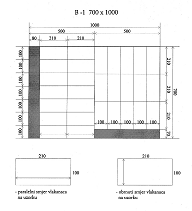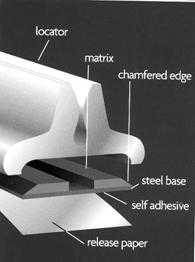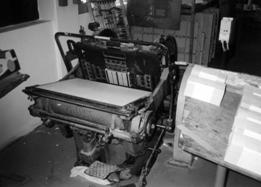
tablica 2
The research described in this paper has been carried out in order to prove that groove quality largelydepends on the quality of the cardboard used,as well as, on relative humidity of conditioning, the quality of grooving channels, and tools used in the grooving process.
Since the parameters that influence groove quality are numerous, this research was restricted and focused on testing the quality of grooves moulded on channels made by CITO creasing matrixes System GmbH, Germany, VIKING iron grooving bands from Austria and KRAUSSE punching machine System GALLY, Germany. Researched material was cardboard of BELPAK BEL/GT 1 quality of various grammage (between 280 and 450 g/m 2 ) produced by KOLICEVO, Slovenia. Cardboards were conditioned prior to grooving.
2 MethodsCardboard number |
Grammage [g/m 2 ] |
Thickness [mm] |
Specific volume [cm 3 /g] |
Producer/Quality |
1 |
280 |
0.35 |
1.25 |
KOLICEVO BEL/GT 1 |
2 |
320 |
0.41 |
1.28 |
KOLICEVO BEL/GT 1 |
3 |
350 |
0.44 |
1.26 |
KOLICEVO BEL/GT 1 |
4 |
450 |
0.57 |
1.27 |
KOLICEVO BEL/GT 1 |

tablica 2
Figure 1. Preparing of boards for grooving
CITO creasing matrixes System GmbH, Germany (Fig. 2) and VIKING iron grooving bands from Austria (dimensions: 23,30 mm high, 0.70 mm wide and 120 mm long) were used for grooving in this work, as well as KRAUSSE punching machine System GALLY, Germany (Fig. 3).

Figure 2. CITO creasing matrix

Figure 3. KRAUSSE punching machine System GALLY, Germany
Cardboard number |
Grammage [g/m 2 ] |
Thickness [mm] |
Channel groove dimensions [mm] |
|
height |
width |
|||
1 |
280 |
0.35 |
0.40 |
1.30 |
2 |
320 |
0.41 |
0.40 |
1.30 |
3 |
350 |
0.44 |
0.40 |
1.30 |
4 |
450 |
0.57 |
0.50 |
1.50 |
3 Results
In Table 3. results of Taber bending stiffness are presented.
Cardboard number |
Grammage [g/m 2 ] |
Taber stiffness [mNm] |
|||
Grain direction |
|||||
MD |
CD |
||||
x |
s |
x |
s |
||
1 |
280 |
84.9 |
9.59 |
45.9 |
18,08 |
2 |
320 |
126.7 |
7.94 |
61.6 |
10.04 |
3 |
350 |
133.5 |
3.43 |
115.2 |
2.48 |
4 |
450 |
159.2 |
6.27 |
124.5 |
3.05 |
Obtained results given in Table 4 and Table 5 show the comparison between the results from Table 4 and the suggested evaluation system from Table 5.
Grammage [g/m 2 ] |
Grain direction |
Relative humidity [%] |
Evaluation (number of occurrences in a sample) |
|||||
0 |
1 |
2 |
3 |
4 |
5 |
|||
280 |
MD |
35 |
5 |
4 |
1 |
0 |
0 |
0 |
50 |
0 |
7 |
3 |
0 |
0 |
0 |
||
75 |
0 |
6 |
3 |
1 |
0 |
0 |
||
CD |
35 |
5 |
4 |
1 |
0 |
0 |
0 |
|
50 |
2 |
7 |
1 |
0 |
0 |
0 |
||
75 |
7 |
3 |
0 |
0 |
0 |
0 |
||
320 |
MD |
35 |
0 |
7 |
3 |
0 |
0 |
0 |
50 |
1 |
4 |
5 |
0 |
0 |
0 |
||
75 |
5 |
5 |
0 |
0 |
0 |
0 |
||
CD |
35 |
0 |
6 |
3 |
1 |
0 |
0 |
|
50 |
1 |
9 |
0 |
0 |
0 |
0 |
||
75 |
7 |
3 |
0 |
0 |
0 |
0 |
||
350 |
MD |
35 |
1 |
3 |
4 |
2 |
0 |
0 |
50 |
1 |
6 |
3 |
0 |
0 |
0 |
||
75 |
2 |
6 |
2 |
0 |
0 |
0 |
||
CD |
35 |
0 |
6 |
3 |
1 |
0 |
0 |
|
50 |
1 |
9 |
0 |
0 |
0 |
0 |
||
75 |
7 |
3 |
0 |
0 |
0 |
0 |
||
480 |
MD |
35 |
0 |
0 |
0 |
3 |
2 |
5 |
50 |
0 |
0 |
0 |
9 |
1 |
0 |
||
75 |
0 |
0 |
3 |
4 |
3 |
0 |
||
CD |
35 |
0 |
0 |
0 |
6 |
2 |
2 |
|
50 |
0 |
0 |
1 |
5 |
4 |
0 |
||
75 |
0 |
2 |
6 |
2 |
0 |
0 |
||
Fibre direction |
Attributive value expressed numerically |
Description of grooves |
Suggested steps |
|
CD |
MD |
|||
|
|
0 |
Grooves indistinguishable. Avoid using the box at all costs. |
Not to be used. |
|
|
1 |
Grooves almost indistinguishable, edges unclear. We do not suggest using such a box. |
|
|
|
2 |
Grooves can be distinguished, but edges are unclear. Groove depth and width blurred.The use is impossible. |
|
|
|
3 |
Grooves can be distinguished,but edges areunclear. Groove depth and widthinexpressive. It could be used for less demanding boxes and manual production, but we do not recommend it. |
Limited use. |
|
|
4 |
Grooves and edges of a good quality, depth and width clearly visible. Can be used for smaller editions. |
To be used for smaller and less demanding editions. |
|
|
5 |
High-quality grooves, clear edges of optimum depth and width. Fibres rounded from the inside and outside. Grooves recommended for larger and high-quality editions. |
To be used for all editions and most demanding box types. |
Table 5. The results
4 Discussion and conclusions
As far as boxes are concerned, a straight and clear edge is one of the most important aesthetic demands. This primarily concerns cardboard packaging used in the food and cosmetic industry, since buyers frequently have a direct contact with it. Such an edge can be obtained only if the folding point has been well prepared during the production process (punching).
The research described in this paper has been carried out in order to prove that groove quality largely depends on the quality and climate conditioning of the cardboard used, as well as on the quality of grooving channels and tools used in the grooving process. Since the slightest change of the mentioned parameters causes a change in the quality of grooves, it is impossible to give simple instructions on how to make box blanks and/or grooves.
After having analysed the research results we can, claim with certainty that cardboard humidity as a function of relative air humidity greatly influences the quality of grooves. Since the parameters that influence groove quality are numerous, this research was restricted and focused on testing the quality of grooves moulded on channels made by CITO creasing matrixes System GmbH, Germany, VIKING iron grooving bands from Austria (dimensions: 23,30 mm high, 0.70 mm wide and 120 mm long) and KRAUSSE punching machine System GALLY, Germany (Fig. 2 and 3). The varying parameters were the grammage of tested cardboards (Table 1), the conditioning of cardboards and height and width of grooving channels (Table 2). Grooving channels were adjusted to cardboard thickness (Table 2).
Since the aim was to define cardboard properties as precisely as possible and to compare the grooving quality by observing the channels, we examined cardboard stiffness using a Taber tester (Table 3). The results of stiffness were given in mNm. Stiffness is naturally influenced by cardboard thickness, which was also tested. As was the case with other parameters, several measurements were performed, each of which was recorded as the average value expressed according to the ISO standards. For instance, cardboard samples weighing 280, 320, 350, and 450 g/m 2 were 0.35, 0.41, 0.44, and 0.57 mm thick, respectively. When all the measurements had been performed, we compared the results, drew up tables and charts, and tried to establish the connection between the results obtained and the grooving quality. The results included additional commentaries, which aimed at explaining each value and conclusion as clearly and logically as possible.
A proposed evaluation system based on the research results was designed: grooving channel quality was assessed according to a model table where attributive qualities were expressed through marks. The system was developed because every cardboard grooving quality research that had previously been conducted warned us about the need to transform the researcher's subjective impression regarding the box design or grooving quality into a more quantifiable assessment. It was, naturally, much of a challenge but we tried to produce an acceptable grooving quality evaluation model that might provide comparative material for any further research. Our experience and a great number of box blanks collected over the years and a substantial number of photographs proved to be great help in the process. Each category is accompanied by a photography, a descriptive assessment, and an explanation, which we hope will help avoid any mistakes that might be made when comparing grooving quality and the chosen evaluation model.
The project represents a solid base for all further researches, which might take the optimum value of the examined parameters as a starting point and vary other product features. Our contribution to industrial production is an especially practical evaluation model, which will allow a quick quality assessment of grooves formed in cardboards. We would also like to point out once again that the most urgent and the most important future research should aim at establishing the connection between grooving quality and relative air humidity by conditioning cardboards through gradual increase of RH (by 5%) during the grooving process.
5 Literature
Babic D., Kropar Vancina V., Cernic Letnar M. (2002) Investigation of the Relation Strength/Grain Direction of the Board Folding Box, Proceedings of the 29th International Annual Symposium, Bled, November 13-15, 2002, Slovenia, pp 92-97
Babic D., Vancina Kropar V., Lajic B, (2003) Relation of Board Box Strength and Grain Direction, Conference Proceedings, MATRIB 2003, Vela Luka, Island Korcula, June 26-28, 2002, Croatia, ISBN 953-7040-01-1, Croatian Society for Materials and Tribology, Zagreb, pp 1-6,
Bureau H. W., (1989), What the Printer Should Know about Paper, Graphic Arts Technical Foundation, Pittsburgh
Cernic Letnar M., Kropar Vancina V., Hladnik A., (2002), Effect of Accelerated Ageing on Degradation of Unprinted and Printed Graphic Paperboards, Proceedings of the 29th International IARIGAI Research Conference, Lake of Lucerne, September 8-11, 2002, Switzerland,
ISBN 3-9520403-2-0, EMPA/Ugra, St. Gallen, pp 216-233
Cernic Letnar M., Kropar Vancina V., (2002) The Effect of Accelerated Ageing on Graphic Paperboards Degradation; Restaurator, 23, pp 118-132
Cernic Letnar M., Scheicher L., Kropar Vancina V., (2000), Optical and Colour Durability of Graphic Board and Laboratory Prints, Proceedings of the 27th International Annual Symposium, Bled, November 15-17, 2000 , Slovenia , pp 133-139
Eldred N. R., (1990), Changes in Temperature and Relative Humidity directly Affect Paper, GATFWORLD, 2, 3, pp 1-4
Kropar Vancina, V.; Cernic Letnar, M.: (2001) Durability of Coated and Uncoated Boards, in Bristow A. J. (Ed), Advances in Printing Science and Technology, ISBN 1 85802 438 2, Pira International, Leatherhead, pp 43-55
Setter V. C. and Gundergon D. E. (1983) in Mark R. E. (Ed) Handbook of Physical and mechanical Testing of paper and Paperboard, Marcel Dekker, New York
Vancina V., Mikota M., Golubovic A., (1992) The Effect of Humidity on the flexural Stiffness of Some Coated Boards, Acta Graph. 4, 4, pp 199-203